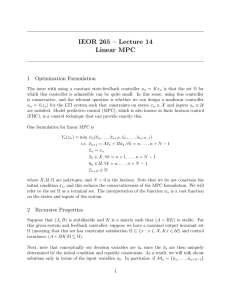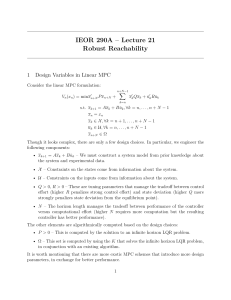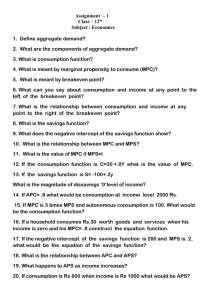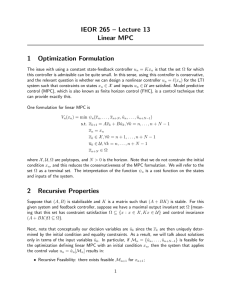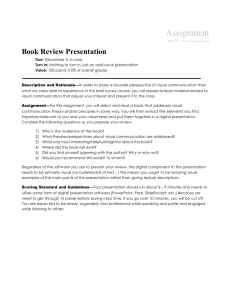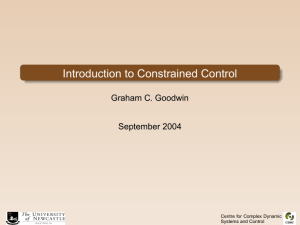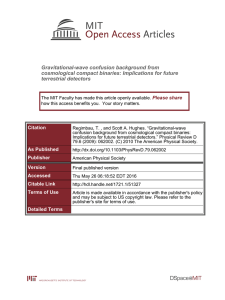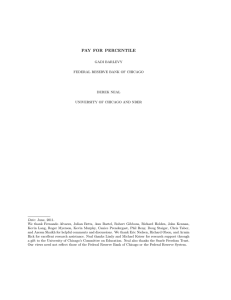IEOR 290A – Lecture 23 Robustness in Tube MPC 1
advertisement
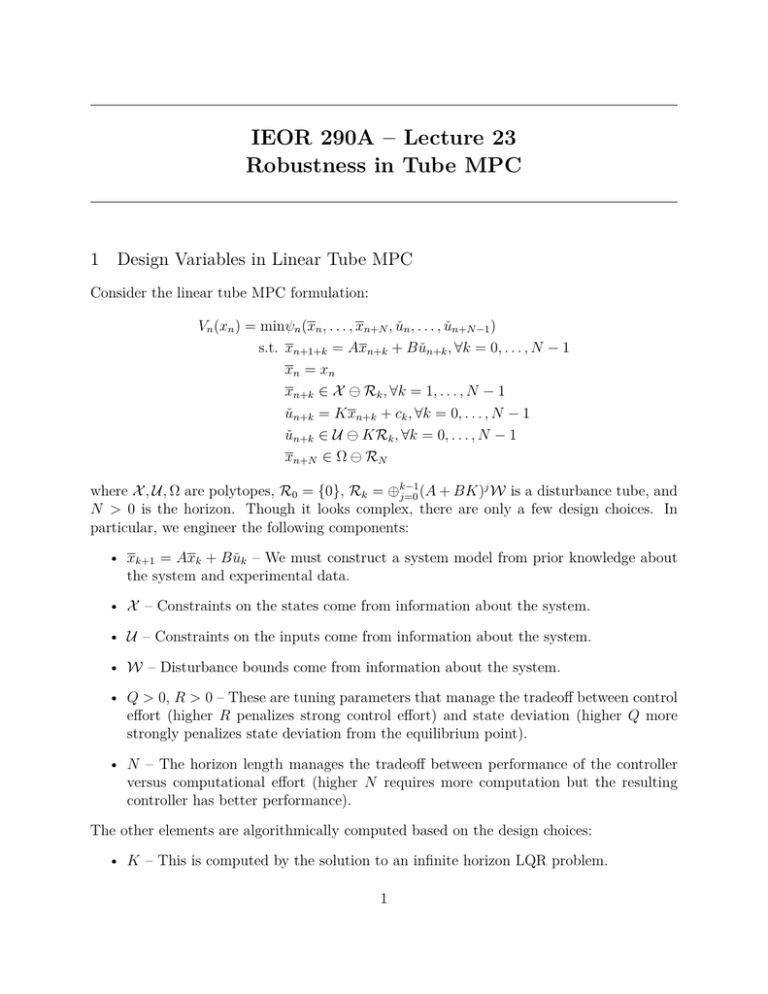
IEOR 290A – Lecture 23
Robustness in Tube MPC
1
Design Variables in Linear Tube MPC
Consider the linear tube MPC formulation:
Vn (xn ) = minψn (xn , . . . , xn+N , ǔn , . . . , ǔn+N −1 )
s.t. xn+1+k = Axn+k + B ǔn+k , ∀k = 0, . . . , N − 1
xn = xn
xn+k ∈ X ⊖ Rk , ∀k = 1, . . . , N − 1
ǔn+k = Kxn+k + ck , ∀k = 0, . . . , N − 1
ǔn+k ∈ U ⊖ KRk , ∀k = 0, . . . , N − 1
xn+N ∈ Ω ⊖ RN
j
where X , U, Ω are polytopes, R0 = {0}, Rk = ⊕k−1
j=0 (A + BK) W is a disturbance tube, and
N > 0 is the horizon. Though it looks complex, there are only a few design choices. In
particular, we engineer the following components:
• xk+1 = Axk + B ǔk – We must construct a system model from prior knowledge about
the system and experimental data.
• X – Constraints on the states come from information about the system.
• U – Constraints on the inputs come from information about the system.
• W – Disturbance bounds come from information about the system.
• Q > 0, R > 0 – These are tuning parameters that manage the tradeoff between control
effort (higher R penalizes strong control effort) and state deviation (higher Q more
strongly penalizes state deviation from the equilibrium point).
• N – The horizon length manages the tradeoff between performance of the controller
versus computational effort (higher N requires more computation but the resulting
controller has better performance).
The other elements are algorithmically computed based on the design choices:
• K – This is computed by the solution to an infinite horizon LQR problem.
1
• P > 0 – This is computed by the solution to an infinite horizon LQR problem.
• Ω – This set is computed by using the K that solves the infinite horizon LQR problem,
in conjunction with an existing algorithm.
• Rk – These sets are computed using standard polytope algorithms for linear transformations and Minkowski sums of polytopes.
It is worth mentioning that there are more exotic MPC schemes that introduce more design
parameters, in exchange for better performance.
2
Continuity of Value Function
In addition to the recursive feasibility and constraint satisfaction properties of tube MPC,
in the presence of disturbance, there are other types of robustness that this method has.
These are in fact related to continuity of the minimizers and value function. In fact, if ψn
is continuous and strictly convex, then the strictly convex variant of the Berge maximum
theorem tells us that the minimizer is continuous and the value function is convex and
continuous.
3
Robust Asymptotic Stability
Recall the following two definitions:
• A function γ : R+ → R+ is type-K if it is continuous, strictly increasing, and γ(0) = 0.
• A function β : R+ × R+ → R+ is type-KL if for each fixed t ≥ 0, the function β(·, t)
is type-K, and for each fixed s ≥ 0 the function β(s, ·) is decreasing and β(s, t) → 0 as
t → ∞.
We can now give our main definition for this section: A system is robustly asymptotically
stable (RAS) if there exists a type-KL function β and for each ϵ > 0 there exists δ > 0, such
that for all dn satisfying maxn ∥dn ∥ < δ it holds that xn ∈ X and ∥xn ∥ ≤ β(∥x0 ∥, n) + ϵ for
all n ≥ 0.
It turns out that the tube MPC formulation has RAS when the objective is given by
ψn =
x′n+N P xn+N
+
N
−1
∑
x′n+k Qxn+k + ǔn+k Rǔn+k ,
k=0
where (A + BK)′ P (A + BK) − P = −(Q + K ′ RK). The proof is somewhat technical and
will not be covered here. The key feature of the proof is that there is a continuous Lyapunov
function for the nominal system, because the value function is continuous. And because
the Lyapunov function shows sufficient descent, small perturbations will not remove descent
except for some region about the origin.
2
